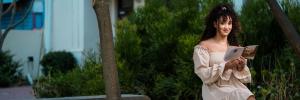
Art graduate's illustrations address past injustices
Karla Koopstad used an experience which is a tender subject for her family (and many others) as inspiration for her MA in Art Education project – a set of wordless booklets portraying the forced evacuations in Ceres under the apartheid dispensation.
Koopstad's dad, the Reverend Willie Koopstad, lived in the Ceres residential area “Whitecity" when the family was forced to move to Area-K (currently Bella Vista) in 1983. In the late 1960s and in the early 1980s, dozens of families were forced to leave their homes.
“When I was a child and even today, my dad would drive through his old neighbourhood when we visit the family in Ceres to show us where he lived before they had to move. He always tells us that they were given no choice.
“And yet my dad took the brave decision – in the very house from which they were evicted – not to become a product of his circumstances, but to rise above them and to help create a better life for the next generation."
This story, which became part and parcel of Koopstad's life, as well as the knowledge she gained during her studies, shaped her project. “In my two master's degree years we learnt a lot about social justice, inclusion and exclusion, as well as several other controversial issues. We also learnt how it can be addressed within the art world and through art and education."
Koopstad, who currently works as an administrative officer at Stellenbosch University (SU), says she was privileged to study with a National Research Foundation bursary and to be involved in one of their continuous projects. “The project focuses on the creation of wordless storybooks that can add value to the education of children and adults, despite language barriers or people's literacy level."
When Koopstad started the research for her project and talked to other people who were also affected by the evictions, she soon realised that it “is something that causes deep sadness". She approached the museum in Ceres for information, but it turned out that some of the stories (such as her dad's) did not form part of the documented history of the town.
To Koopstad it is important that her dad's and so many other people's stories should be told. “These displacements are indicative of the injustices done to communities in smaller towns during the apartheid years, yet one does not hear much about it. Precisely because they still elicit strong feelings, it is important that these stories should be shared with the younger generations."
For example, one of the booklets tells the story of a family who was forced out of the Rooikamp area. “A court order was obtained to evict the family. The person I talked to, was in Grade 2 at that stage. One afternoon when he left school, he didn't have a home to go back to anymore. His family had to go and live with their aunt for the time being."
Koopstad explains that by only using visual elements to illustrate the stories, readers are given the opportunity to interpret the story themselves and to make them their own. “It will be interesting to see how the stories are 'read' by different generations and what lessons are learnt from them.
“I decided to use sepia for the illustrations and colouring of the booklets. Sepia colours evoke the feeling of the older photographs from the 1900s. The booklets also serve as a kind of photo album, providing a glimpse of the life of the people who were evicted and the events of the time."
The booklets are available online and free of charge at www.collaboratecommunityprojects.org.
More about Karla Koopstad
She was born in Paarl but grew up and went to school in Stellenbosch. Although art wasn't one of her school subjects, she used to draw and design in her free time. “When I heard about the art courses at SU, I wasted no time in drawing up my portfolio and applying. I knew my lack of art knowledge could hamper me, but my parents taught me to always try my best. You never know what could have been if you don't try. Obviously, the Department of Visual Arts saw something in my work," she laughs.
In the meantime, she has developed an interest in digital art and wishes to expand her knowledge about it. In future, she hopes to use her art to educate others, whether as a teacher, online or administratively. “I'm excited about all the opportunities and possibilities out there!"
Photo: Stefan Els
